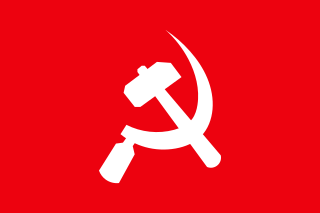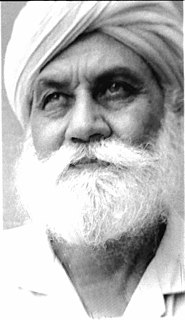
A Naxal or Naxalite is a member of militant political organisation that claims the legacy of the Communist Party of India (Marxist–Leninist), founded in Calcutta in 1969.

Unity Centre of Communist Revolutionaries of India (Marxist-Leninist) [Harbhajan Sohi], a splinter group of UCCRI(ML). Since July 1977 the UCCRI(ML) Central Committee Member from Punjab, Harbhajan Sohi had started to express criticism towards the Three Worlds Theory of the Communist Party of China. Gradually he got closer to the positions of the Albanian Party of Labour. In January 1979 the Punjab State Committee of UCCRI(ML) submitted a document to the Central Committee on the issue. The majority of the CC responded by producing a document titled "In Support of Differentiation of Three Worlds Theory" in April the same year. On 20 September the split was a fact, and the Punjab State Committee formed a parallel UCCRI(ML).

The Insurgency in Punjab that started in the early 1980s, was an armed campaign by the Sikh nationalist Khalistan movement. In the 1980s, the movement had deteriorated into a secessionist movement after the perceived indifference of the Indian state in regards to mutual negotiations. The Green Revolution brought several social and economic changes which, along with factionalism of the politics, in the Punjab state increased tension between rural Sikhs in Punjab with the union Government of India. Pakistani strategists then began supporting the militant dimension of the Khalistan movement.

Sahajanand Saraswati( real name Navrang Rai )pronunciation (help·info) was an ascetic, a nationalist and a peasant leader of India.

The Communist Ghadar Party of India is a far-left political party that is committed to a communist revolution in India based on Marxism–Leninism.
The Maoist Communist Centre (MCC) was one of the largest two armed Maoist groups in India, and fused with the other, the People's War Group in September 2004, to form the Communist Party of India (Maoist).
The All India Sikh Students Federation (AISSF), is a Sikh student organisation and political organisation in India. AISSF was formed in 1943. as the youth wing of the Akali Dal, which is a Sikh political party in the Indian Punjab.

The Unity Centre of Communist Revolutionaries of India (Marxist–Leninist) was a communist organisation in India, which emerged from a split in the Unity Centre of Communist Revolutionaries of India (Marxist-Leninist) in 1982.
The Bharatiya Kisan Sangh (BKS) is an Indian farmers' organization that is politically linked to the Rashtriya Swayamsevak Sangh, and a member of the Sangh Parivar. BKS was founded by Dattopant Thengadi in 1978. As of 2000, Rashtriya Swayamsevak Sangh claimed BKS had a quarter million members, organized in 11,000 villages and 301 districts across the country. The organization is dominated by landed gentry.

Baba Bujha Singh was an Indian revolutionary leader. He was an activist of the Ghadar Party and later became a key leader of the Lal Communist Party. Singh later became a symbol of the Naxalite movement in Punjab.
Moni Guha was an Indian communist.
Satyanarayan Singh was an Indian communist politician. Singh was one of the early leaders of the Communist Party of India (Marxist-Leninist), being its secretary in Bihar.

Teja Singh Sutantar, also Swatantar, was a national revolutionary of India who fought for the independence of India from the British Empire and for the liberation of Punjab peasantry from the clutches of feudal lords. He became actively involved in the revolutionary activities during the 1920s when the Ghadar Party was preparing for the second attempt for the overthrow of British government. Sutantar was sent to Turkey in 1924 where he joined the Turkish military academy to attain military knowledge. In and out of prison several times, Sutantar was among the top national Communist leaders jailed by the British administration in the Deoli Detention Centre in the early-1940's.

Lal Singh Dil was one of the major revolutionary Punjabi poets emerging out of the Naxalite (Marxist-Leninist) Movement in the Indian Punjab towards the late sixties of the 20th century. The Movement was a political failure and died down quickly, but it brought in revolutionary changes in the subject matter, language and idiom, tone and tenor of Punjabi poetry. Referring to the impact of the Naxalite Movement in Punjab, Paramjit S. Judge says, 'The consequences of the Naxalite movement have been almost ephemeral and have hardly made an impact on the social and political spheres… Its positive contribution is that it has revolutionized Punjabi poetry which can never be traditional and romantic again.' 'The prominent poets belonging to this school are: Pash, Lal Singh Dil, Harbhajan Halvarvi, Darshan Khatkar, Amarjit Chandan and Sant Ram Udasi,' says Paramjit S Judge. About Lal Singh Dil, Prof Ronki Ram says, 'He was one of the most popular and serious poets of the Naxal Movement in Punjab of the late 1960s.'
The Mahila Atma Raksha Samiti was a women's movement in Bengal, India. MARS was a mass organisation linked to the Communist Party of India.
The Lal Communist Party Hind Union was a political party in Punjab, India. The party was led by Teja Singh Swatantra. It led militant agrarian struggles in the PEPSU regions. The Lal Communist Party merged back into the Communist Party of India in 1952.
Sant Ram Udasi was one of the major Punjabi poets emerging out of the Naxalite movement in the Indian Punjab towards the late 1960s, writing about revolutionary and Dalit consciousness. Lok Kavi Sant Ram Udasi Memorial Trust (International) was established as a research foundation focusing on the life and works of Sant Ram Udasi.

Sindicato Labrego Galego-Comisións Labregas is a Galician farmers and breeders union centered on family farms and small peasants.

Shatranj (transl. Chess) is a 1969 Indian Hindi-language spy thriller film co-produced and directed by S. S. Vasan. His final directorial venture, it stars Rajendra Kumar, Waheeda Rehman, Mehmood, Shashikala, Helen, Achala Sachdev and Agha.
Central Organising Committee, Communist Party of India (Marxist–Leninist) was a communist party in India, one of the main splinter factions of the original Communist Party of India (Marxist–Leninist). COC, CPI(ML) occupied a middle position between the pro-Charu Majumdar group led by Mahadev Mukherjee and the anti-Majumdar group led by Satyanarayan Singh. Failing to articulate a common ideological position, COC, CPI(ML) soon suffered internal divisions and splits. Two of the splinter groups of COC, CPI(ML) in Andhra Pradesh are predecessors of the present-day Communist Party of India (Maoist).










